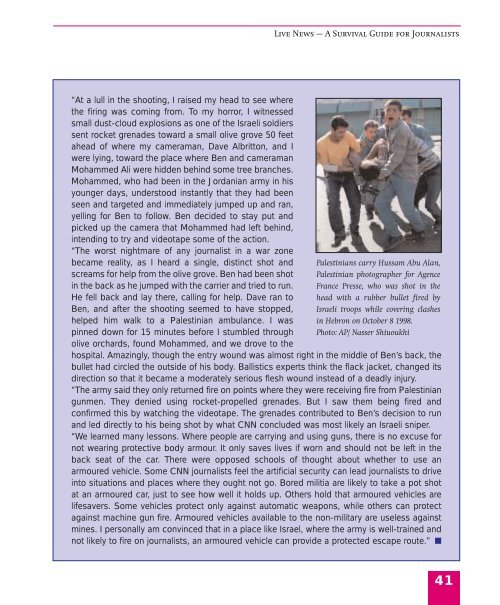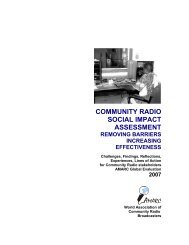Live News - A Survival Guide - International Federation of Journalists
Live News - A Survival Guide - International Federation of Journalists
Live News - A Survival Guide - International Federation of Journalists
- No tags were found...
Create successful ePaper yourself
Turn your PDF publications into a flip-book with our unique Google optimized e-Paper software.
<strong>Live</strong> <strong>News</strong> — A <strong>Survival</strong> <strong>Guide</strong> for <strong>Journalists</strong>“At a lull in the shooting, I raised my head to see wherethe firing was coming from. To my horror, I witnessedsmall dust-cloud explosions as one <strong>of</strong> the Israeli soldierssent rocket grenades toward a small olive grove 50 feetahead <strong>of</strong> where my cameraman, Dave Albritton, and Iwere lying, toward the place where Ben and cameramanMohammed Ali were hidden behind some tree branches.Mohammed, who had been in the Jordanian army in hisyounger days, understood instantly that they had beenseen and targeted and immediately jumped up and ran,yelling for Ben to follow. Ben decided to stay put andpicked up the camera that Mohammed had left behind,intending to try and videotape some <strong>of</strong> the action.“The worst nightmare <strong>of</strong> any journalist in a war zonebecame reality, as I heard a single, distinct shot andscreams for help from the olive grove. Ben had been shotin the back as he jumped with the carrier and tried to run.He fell back and lay there, calling for help. Dave ran toBen, and after the shooting seemed to have stopped,helped him walk to a Palestinian ambulance. I waspinned down for 15 minutes before I stumbled througholive orchards, found Mohammed, and we drove to thePalestinians carry Hussam Abu Alan,Palestinian photographer for AgenceFrance Presse, who was shot in thehead with a rubber bullet fired byIsraeli troops while covering clashesin Hebron on October 8 1998.Photo: AP/ Nasser Shiuoukhihospital. Amazingly, though the entry wound was almost right in the middle <strong>of</strong> Ben’s back, thebullet had circled the outside <strong>of</strong> his body. Ballistics experts think the flack jacket, changed itsdirection so that it became a moderately serious flesh wound instead <strong>of</strong> a deadly injury.“The army said they only returned fire on points where they were receiving fire from Palestiniangunmen. They denied using rocket-propelled grenades. But I saw them being fired andconfirmed this by watching the videotape. The grenades contributed to Ben’s decision to runand led directly to his being shot by what CNN concluded was most likely an Israeli sniper.“We learned many lessons. Where people are carrying and using guns, there is no excuse fornot wearing protective body armour. It only saves lives if worn and should not be left in theback seat <strong>of</strong> the car. There were opposed schools <strong>of</strong> thought about whether to use anarmoured vehicle. Some CNN journalists feel the artificial security can lead journalists to driveinto situations and places where they ought not go. Bored militia are likely to take a pot shotat an armoured car, just to see how well it holds up. Others hold that armoured vehicles arelifesavers. Some vehicles protect only against automatic weapons, while others can protectagainst machine gun fire. Armoured vehicles available to the non-military are useless againstmines. I personally am convinced that in a place like Israel, where the army is well-trained andnot likely to fire on journalists, an armoured vehicle can provide a protected escape route.” ■41
















